Thanks For The Visit !

Farmboyzim's Freeware Finds
Curtiss F9C-2 "Sparrowhawk"
Review by Farmboyzim
Curtiss F9C-2 "Sparrowhawk"
Review by Farmboyzim


Here’s a Farmboyzim Freeware Find that I did not have to look too far for at all! This particular model comes to you, from me! This is my first model, and it was quite the learning process! In past reviews I have praised the freeware developers out there. Now I know more of what it takes to get a bird in the air. Lots of work! I created the textures as well and the panel for the model. Default gauges and sounds were used. There are certainly many more additions to detail that need to be made, but I wanted to get this out to all you folks that have been a fan of “Farmboyzim” over the years, as a little Yule Time Present!
A little history behind the F9C-2 “Sparrowhawk” is in order. The F9C-2 was a small biplane fighter with a big reputation. The Curtiss F9C Sparrowhawk had originally been designed as a small single-seat shipboard fighter developed in response to a
A little history behind the F9C-2 “Sparrowhawk” is in order. The F9C-2 was a small biplane fighter with a big reputation. The Curtiss F9C Sparrowhawk had originally been designed as a small single-seat shipboard fighter developed in response to a

www.farmboyzimsflightsims.com
FBZFS
Curtiss F9C-2 "Sparrowhawk"
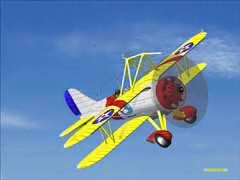
Navy request made back on May 10, 1930. It was in competition with the General Aviation (formerly the Fokker Company) XFA-1 and the Berliner-Joyce XFJ-1.
During the era of the rigid airships, the USS Akron and the USS Macon were outfitted to launch and recover these aircraft in mid-air, and they came to be known as “parasite” fighters. Its primary mission was that of reconnaissance, which gave the airship an even greater surveillance range.
A very interesting and challenging technique was used to launch and recover the F9C-2 from the airships. Nicknamed the “Flying Trapeze” by the aircrews, a hook and anchor system was developed. The Sparrowhawk had a hook attached to its top wing, which in turn, latched onto a bar that was in the hanger bay of the airship. For launch, the aircraft would be lowered outside of the airship and then released into a freefall, where the pilots would regain control of the aircraft and form up.
During the era of the rigid airships, the USS Akron and the USS Macon were outfitted to launch and recover these aircraft in mid-air, and they came to be known as “parasite” fighters. Its primary mission was that of reconnaissance, which gave the airship an even greater surveillance range.
A very interesting and challenging technique was used to launch and recover the F9C-2 from the airships. Nicknamed the “Flying Trapeze” by the aircrews, a hook and anchor system was developed. The Sparrowhawk had a hook attached to its top wing, which in turn, latched onto a bar that was in the hanger bay of the airship. For launch, the aircraft would be lowered outside of the airship and then released into a freefall, where the pilots would regain control of the aircraft and form up.
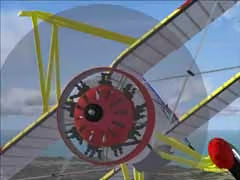
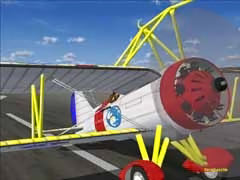
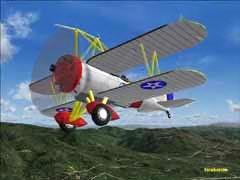
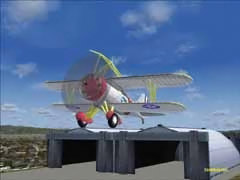
Recovery was just the opposite, although a bit more challenging. The airship would build up speed to somewhere around 40 miles per hour, which was just about the stall speed of the F9C-2, and the Sparrowhawk would slowly and carefully maneuver into a position that allowed them to hook up to the same bar that hoisted them out. Once hooked, the aircraft was hoisted inside of the airship, into its hanger bay, where a total of four aircraft could be stowed, with one ready to go on the hook/bar, for a total of 5 aircraft.
The range of the F9C-2 (297 Miles) was increased by removing the landing gear, once the aircraft were on board. An external tank would be fitted to the underside of the aircraft, extending its range. The aircraft, although operating from the airships, did not take off on board the airship, but would take off from the ground and hook up with the airship while in flight. In this way, the airship was able to carry extra fuel or ballast, the aircraft being supported by the dynamic lift of the airship.
The range of the F9C-2 (297 Miles) was increased by removing the landing gear, once the aircraft were on board. An external tank would be fitted to the underside of the aircraft, extending its range. The aircraft, although operating from the airships, did not take off on board the airship, but would take off from the ground and hook up with the airship while in flight. In this way, the airship was able to carry extra fuel or ballast, the aircraft being supported by the dynamic lift of the airship.
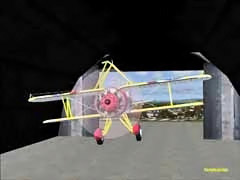
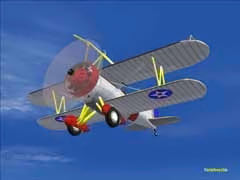
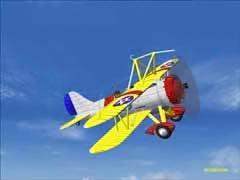
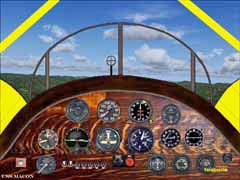
The Akron was lost at sea off New Jersey on April 4, 1933, but no airplanes were aboard the airship at that time. The Sparrowhawks were then transferred to the Macon, based at Moffett Field, California, whose fate, unfortunately, was the same as that of the Akron. The Macon went down off the coast of California, near Monterey. This was the beginning of the end for the rigid airship days for the military.
Only one Sparrowhawk survives today, and its home is the Smithsonian Institutions Air and Space Museum. The original aircraft were first assigned to the USS Akron, but she went down and was lost. The planes were not on board at the time of the crash. They found a new home aboard the USS Macon, whose fate, unfortunately, was the same as that of the Akron. The Macon went down off the coast of California, near Big Sur.
Only one Sparrowhawk survives today, and its home is the Smithsonian Institutions Air and Space Museum. The original aircraft were first assigned to the USS Akron, but she went down and was lost. The planes were not on board at the time of the crash. They found a new home aboard the USS Macon, whose fate, unfortunately, was the same as that of the Akron. The Macon went down off the coast of California, near Big Sur.
Curtiss F9C-2 Specifications…
·Crew: 1
·Length: 21.08 ft (6.27 m)
·Wingspan : 25.5 ft (7.75 m)
·Height: 10.92 ft (3.34 m)
·Wing area: 185 ft² (16.1 m²)
·Empty weight: 2,114 lb (961 kg)
·Loaded weight: 2,776 lb (1,262 kg)
·Powerplant: 1× Wright R-975-22 radial engine, 415 hp (310 kW)
Performance
·Maximum speed : 176 mph (153 knots, 283 km/h)
·Range : 297 mi (258 nm, 475 km)
·Service ceiling : 19,200 ft (5,853 m)
·Rate of climb : 1,690 ft/min (8.6 m/s)
·Wing loading : 15 lb/ft² (78 kg/m²)
·Power/mass : 0.15 hp/lb (240 W/kg)
Armament
·Guns: 2× 0.30 in (7.62 mm) machine guns
·Crew: 1
·Length: 21.08 ft (6.27 m)
·Wingspan : 25.5 ft (7.75 m)
·Height: 10.92 ft (3.34 m)
·Wing area: 185 ft² (16.1 m²)
·Empty weight: 2,114 lb (961 kg)
·Loaded weight: 2,776 lb (1,262 kg)
·Powerplant: 1× Wright R-975-22 radial engine, 415 hp (310 kW)
Performance
·Maximum speed : 176 mph (153 knots, 283 km/h)
·Range : 297 mi (258 nm, 475 km)
·Service ceiling : 19,200 ft (5,853 m)
·Rate of climb : 1,690 ft/min (8.6 m/s)
·Wing loading : 15 lb/ft² (78 kg/m²)
·Power/mass : 0.15 hp/lb (240 W/kg)
Armament
·Guns: 2× 0.30 in (7.62 mm) machine guns
I am pleased with my first time effort, although I am aware of a few things that need attention. The model could use a bit more detailing inside and out, but still looks pretty darn good, even if I do say so myself! As for the Flight Dynamics, there was a LOT of back and forth adjustments made, and countless referrals to other freeware models, to see how they “ticked”. Having never flown a Biplane Fighter, the actual “feel” is a guess on my part. This also came about from flying various other models to see how they reacted in the virtual blue.
I created the model with Abacus’s FS Studio 3.5, and I used the Flight1 utility, FS Panel Studio in creating the panel. I’m very proud of this model, and I hope to make it even better in the future.
I learned quite a lot about what goes into making a model from start to finish, including creating textures, applying those textures, and especially finding out finally, just what the heck all those numbers and strange terms and initials stood for. It really is a fun part of the hobby to branch off into. I found all stages in the creation process of this model not only fun, but…dare I say it? Educational! You learn quite a lot about the aircraft that you are creating, but you also learn a little about what makes an aircraft fly and handle the way they do. This is a hobby of patience though, if you want your work to look decent. My respect for the folks that have created and are still creating aircraft and scenery as freeware has been raised even higher!
I am working on the USS Macon now, and will keep the site updated as to its progress. I hope you enjoy my little aircraft!
FBZ \|/
I created the model with Abacus’s FS Studio 3.5, and I used the Flight1 utility, FS Panel Studio in creating the panel. I’m very proud of this model, and I hope to make it even better in the future.
I learned quite a lot about what goes into making a model from start to finish, including creating textures, applying those textures, and especially finding out finally, just what the heck all those numbers and strange terms and initials stood for. It really is a fun part of the hobby to branch off into. I found all stages in the creation process of this model not only fun, but…dare I say it? Educational! You learn quite a lot about the aircraft that you are creating, but you also learn a little about what makes an aircraft fly and handle the way they do. This is a hobby of patience though, if you want your work to look decent. My respect for the folks that have created and are still creating aircraft and scenery as freeware has been raised even higher!
I am working on the USS Macon now, and will keep the site updated as to its progress. I hope you enjoy my little aircraft!
FBZ \|/
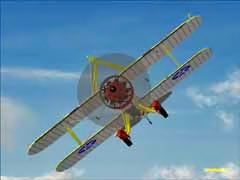
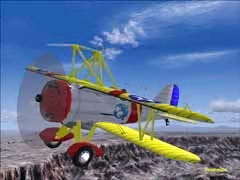
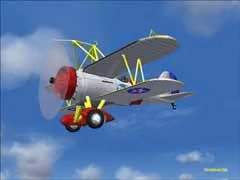
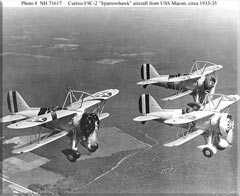
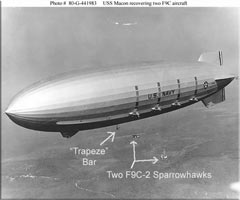
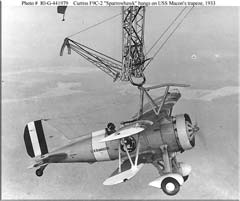
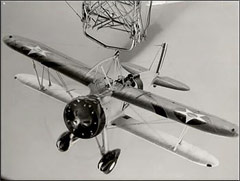
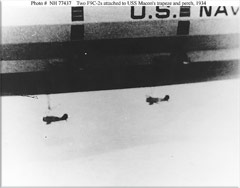
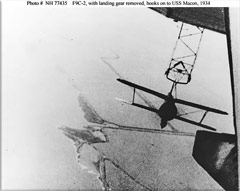
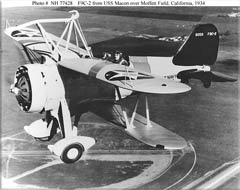
Wright R-975-22 radial engine
The "Men on the Flying Trapeze" markings
Over Grants Pass, Oregon
Taking off from Moffett Field, CA with the Macon's hangers in the background.
Not the authentic panel, but it works!
I couldn't resist! I wonder if the real Sparrowhawk pilots could?
A small plane with a big attitude!
Hook mechanism can be seen plainly here.
Here are some old Dept. of the Navy pictures of both the USS Macon and the Sparrowhawks...
